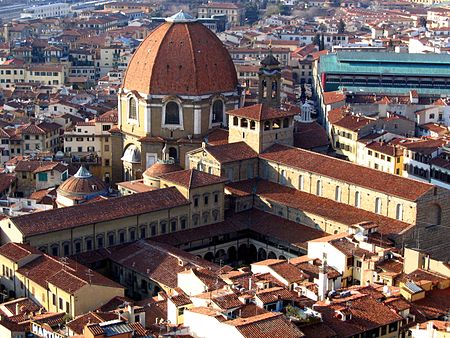Medici Chapel

The Medici Chapels (Cappelle medicee) are two structures at the Basilica of San Lorenzo, Florence, Italy, dating from the 16th and 17th centuries, and built as extensions to Brunelleschi's 15th-century church, with the purpose of celebrating the Medici family, patrons of the church and Grand Dukes of Tuscany. The Sagrestia Nuova ("New Sacristy") was designed by Michelangelo. The larger Cappella dei Principi ("Chapel of the Princes"), although proposed in the 16th century, was not begun until the early 17th century, its design being a collaboration between the family and architects. These are not to be confused with the Magi Chapel in the Palazzo Medici Riccardi, then the main Medici home, that houses a famous cycle of frescoes by Benozzo Gozzoli, painted around 1459.
Excerpt from the Wikipedia article Medici Chapel (License: CC BY-SA 3.0, Authors, Images).Medici Chapel
Piazza Madonna degli Aldobrandini, Florence Quartiere 1
Geographical coordinates (GPS) Address Nearby Places Show on map
Geographical coordinates (GPS)
| Latitude | Longitude |
|---|---|
| N 43.7751444444 ° | E 11.2535722222 ° |
Address
Cappella dei Principi
Piazza Madonna degli Aldobrandini
50123 Florence, Quartiere 1
Tuscany, Italy
Open on Google Maps










